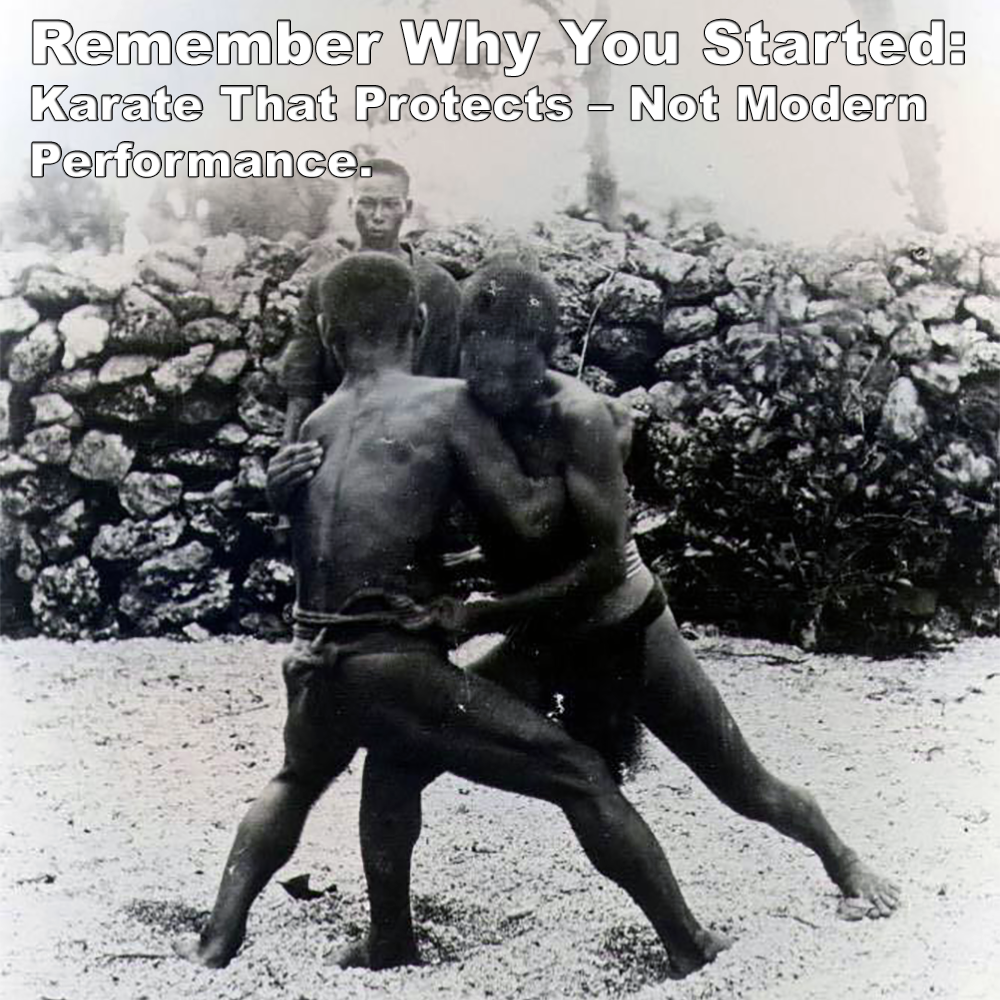
Remember Why You Started: Karate That Protects – Not Modern Performance.
Posted by ADAM CARTER on SEP 29, 2025

Remember Why You Started: Karate That Protects – Not Modern Performance.
(Approx 2 minute 40 second read)
When I started karate back in 1974 I wanted to learn to protect myself, I wanted self-defense. Someone said in a comment recently that “most people who do karate have very little interest in self-defense.” I disagree.
In my experience, most people begin karate because they want to learn to protect themselves. Maybe they were bullied, perhaps they live in a bad area. Maybe they witnessed something worrying. The list goes on. Over the decades I have taught, many of the students I have asked say that they want to feel safer, to protect themselves.
The problem is that too often they don’t get what they asked for. Instead they’re steered into tradition, sport, or something advertised and described as self-defense but isn’t. But if much of today’s karate is acknowledged as artificial and unrelated to real violence, I don’t see how it can be an effective starting point for self-defense. At best it points people in the wrong direction.
An instructor friend of mine told us about a senior dan grade who claimed that modern karate “added finesse” and transformed primitive methods into an art. Really?
What began as 1930s modernization hardened into 1960s dogma, and much of the karate world has been stuck there ever since. Surface-level methods have been polished to look good, but have no connection to the original purpose.
Now if you’re not interested in protecting yourself in the real world, if you’re comfortable with karate for other reasons, then that’s fine, stop reading here.
For the rest that may have an interest. Karate has been hollowed out. Associations pushed precision, repeatable exercises and tournament-ready routines, and stripped away the self-defense at its core.
Drills are defended not because they work, but because they’re easy to teach and easy to grade. Whether they prepare anyone for real violence rarely enters the conversation.
Some justify them as being good for beginners or colored belts. Others call them a first stage before sparring. A few even concede they’re just “warm-ups”.
But if you already know a drill wouldn’t work in a real assault, then be honest about what it’s for.
The distances and timings used in these drills have nothing to do with any kind of real-world altercation. Reflexes, footwork, and coordination should be trained for functionality, not how snappy your karate-gi is.
If your interest is not self-defense training that’s fine, but the drills should always be practiced in the context they are intended for. Teaching self-defense under the guise of tradition, or starting with drills that aren’t realistic, does no one any favors.
Many people message me to say that karate is “more than self-defense”, that it’s about rituals, stances, exercises, and tradition. Let me be clear: I am not interested in self-defense to the exclusion of everything else. I value the richness of karate, the history, the discipline, and many other aspects. But self-defense is the priority, that’s why I was drawn to it in 1974. If you take it away, for me, karate is no longer whole.
This didn’t happen by chance. It happened because associations wanted something marketable: simple drills to teach, tournament rules to govern, and products to sell. Ego and profit took the place of honesty and function. The result is a karate that entertains but doesn’t protect.
Karate primarily was a fighting art, not a sport, a stage act, or a business model. The pioneers built it as a method of survival. Yes, some them began that change.
But at the end of the day, it’s up to you what you want? Just remember though, it doesn’t matter how snappy your karate-gi is, it won’t help you get home safely.
Written by Adam Carter – Shuri Dojo
Photo Credit: Patrick McCarthy Hanshi. - Early 1900s Okinawan students practicing ‘tegumi’, a traditional form of Okinawan grappling sometimes likened to ‘Okinawan sumo’. Techniques from tegumi can still be found in old-style karate.
